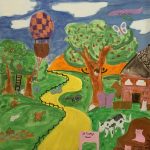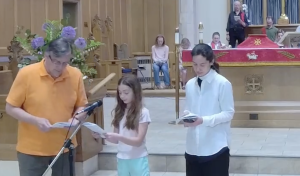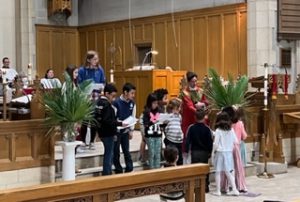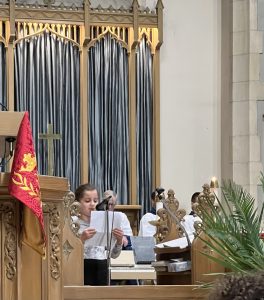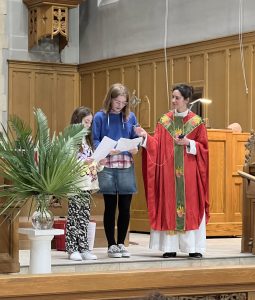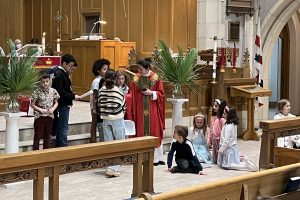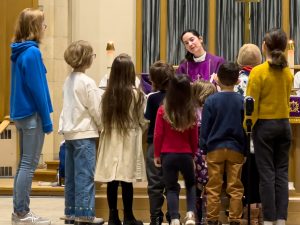
Children share in the ownership of our community, and have multiple opportunities to contribute to it. They lead worship by reading, singing, and expressing their thoughts during the Children’s Message and “relaxed” services. Kids lead activities, enrich the church space with their art, and perform songs and plays during the worship times.
Sundays
The Children’s Message is a short, interactive lesson given by the clergy (usually the Priest in Charge) at the start of each service, on the theme of the Sunday readings. It illustrates one or two points on which the adult sermon later elaborates, usually using an object, toy, activity, or magic trick. This replaces the didactic portion of what would be traditional “Sunday School”. It allows the adults to hear the lesson as well, and discuss it with the children at home or over coffee time at church, and it is always related to the same texts as the adult message. Weekly Facebook post recap the lessons using pictures:
The Children’s Program then runs alongside the service. The children leave after their message and return by Communion time. This gives them an hour devoted to professional instruction in various disciplines: cooking, visual art, dance, music, drama, etc. The products of these programs are presented to the congregation on a regular basis. For example, the artwork hangs in the church (picture below), and the kids are gradually composing the musical setting for “St Tim’s Children’s Mass” that gets incorporated in the Relaxed Service liturgies. Children are divided into small groups based on age; age groupings are flexible depending on who is in attendance. Please refer to the Home Page for current programming.
All artistic endeavours are children-led. So they write their scripts, sketch their designs, and write their own music. The main goal of the 1 hour children’s program is to cultivate, through the arts, the Golden Rule values that are shared among most cultures of the world, and help children think through how they might apply them in real life situations.
The neighbours who do not attend church have the option to drop off the children directly into the art instruction. During the art making, the exposure to scriptural narratives is implicit, while the focus on character development is explicit. The didactic Christian teaching occurs at the beginning of the service, allowing 1) each professional (clergy and artists) do what they know best, 2) have a model from which non-religious families can benefit by skipping the didactic portion, and 3) having adults be very aware of what the children are learning, so they may offer support and growing together in faith and knowledge.
This is a unique and experimental model of delivering children’s teaching.
Teens Programming (ages turning 12 and up) includes dedicated discussion sessions with the priest-in-charge that take place over the first half of the Sunday morning service, once a month. Please refer to the Home Page for dates. On other Sundays, teens are included in the standard Children’s Programming as participants and volunteers.
Children’s Music Practices take place before the Relaxed Services (see below), to enable the children’s musical contribution to our services. No prior formal musical instruction required.
Relaxed Services
Occur monthly on Saturdays at 6 pm, and occasionally on Sunday mornings. These are opportunities for the children to stay for the duration of the whole service, adapted with regards to language, complexity, duration, and musical repertoire. The slightly elaborated Children’s Message is the homily. Children perform as many leading roles as possible; reading, serving, etc. And they get the best seats in the house to see the action at the altar as closely as possible. They become educated about different components of worship so that to understand why we do certain things at church in certain ways. Please refer to the Home Page for upcoming dates and times.
Chie Little

